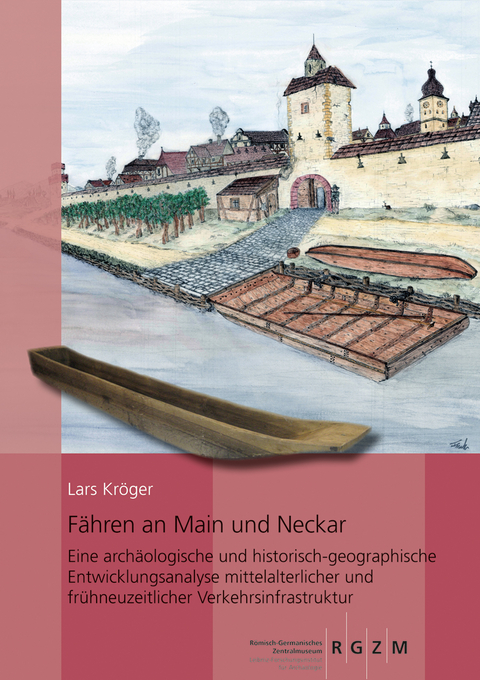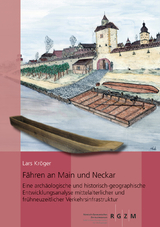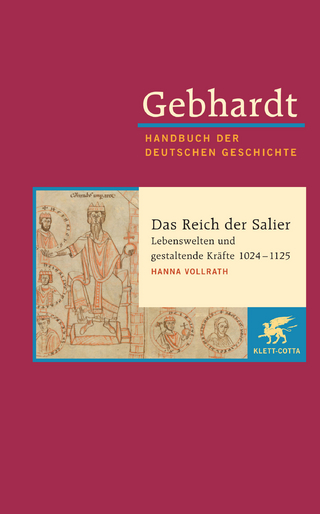Fähren an Main und Neckar
Eine archäologische und historisch-geographische Entwicklungsanalyse mittelalterlicher und frühneuzeitlicher Verkehrsinfrastruktur
Seiten
2023
Leibniz-Zentrum für Archäologie (LEIZA) (Verlag)
978-3-88467-351-5 (ISBN)
Leibniz-Zentrum für Archäologie (LEIZA) (Verlag)
978-3-88467-351-5 (ISBN)
Flüsse wie der Main und der Neckar bilden das Herzstück vieler Kulturlandschaften. Sie verbinden Räume miteinander und bieten umfangreiche Möglichkeiten zur kulturellen und wirtschaftlichen Entfaltung entlang ihrer Ufer. Gleichzeitig bilden sie auch eine Barriere, welche nicht ohne Weiteres überwunden werden kann. Gerade an schiffbaren Flussabschnitten muss eine Infrastruktur bereitstehen, die verlässlich funktioniert, aber die Nutzung des Flusses nicht oder nur gering einschränkt. Flussübergänge bilden einen Flaschenhals im Straßensystem. Sie sind von erheblicher politischer wie auch monetärer Bedeutung und wollen kontrolliert und reguliert werden. Während aus ur- und frühgeschichtlichen Zeiten nur bruchstückhafte Informationen hierzu vorliegen, zeigen das Mittelalter und die frühe Neuzeit eine große Komplexität der Verhältnisse, welche vorrangig auf dem Einsatz von Fähren basiert. Die vorliegende Studie analysiert die verfügbaren archäologischen und schriftlichen Quellen an den Flusssystemen Main und Neckar, um ein geschlossenes Bild der Entwicklung der Flussübergänge zu erhalten. Die archäologische Analyse basiert auf der großen Anzahl von 121 im Arbeitsgebiet gefundenen Einbäumen, die in der Regel Bestandteile komplexerer Fährkonstruktionen bildeten. Diese Vielzahl ermöglicht es, lokale und zeitliche Unterschiede herauszuarbeiten, stellt diese anderen Regionen in Europa gegenüber und erlaubt verlässliche bauliche Rekonstruktionen. Um Fragen der Besitzverhältnisse, Rechtsgrundlagen und allgemeinen Nutzungsverhältnisse an Fähren und Brücken zu klären wurden die publizierten Quellen des Mittelalters und der Neuzeit zu 241 Flussübergängen erfasst und ausgewertet. Sie zeigen ein komplexes System aus Rechten und Pflichten, dem Lehnsherren, Fährleute und Fahrgäste unterworfen waren. Gleichzeitig wird deutlich, dass - anders als häufig angenommen - Furten im klassischen Sinn keinerlei Bedeutung an den schiffbaren Abschnitten der Flüsse besaßen. Die vorliegende Arbeit bietet somit einen fundierten Einblick in die regionalen und überregionalen Transportsysteme im Herzen Mitteleuropas.
Rivers such as the Main and Neckar in Germany are the heart of many cultural landscapes. They connect spaces and enable a variety of cultural and economic developments along their banks. At the same time, they form a barrier not easy to cross. Especially at navigable river sections, a reliable infrastructure needs to be provided, that does not disturb or only minimally interferes in the usability of the river. River crossings represent bottleneck situations in road systems. They possess a political and monetary value demanding for regulation and control. For prehistoric periods only fragmented information is accesseable, the medieval and early modern times show a profound complexity of circumstances. The solution to solve this issue is in most cases the use of ferries.The present study analyses the available archaeological and written sources for the river systems of Main and Neckar in southern Germany. This provides a comprehensive picture of the development of river crossings. The archaeological analysis is based on the exceptional number of 121 logboat finds from the working area. In most cases, they have been parts of complex ferry constructions. This incomparable number allows the definition of local and temporal differences, sets them in contrast with finds from other European regions and gives the opportunity for reliable technical reconstructions.To solve questions on ownership, legal basis and general use conditions of ferries and bridges published written sources from medieval and modern times on 241 river crossings in the area have been examined and evaluated. They represent a complex system of rights and duties concerning liege lords, ferrymen and ferry passengers. At the same time, it became obvious that fords in typical means did not play a role on navigable rivers other than expected. In this way, this study offers a profound glimpse into regional and supra-regional transportation systems in the heart of Middle Europe.
Rivers such as the Main and Neckar in Germany are the heart of many cultural landscapes. They connect spaces and enable a variety of cultural and economic developments along their banks. At the same time, they form a barrier not easy to cross. Especially at navigable river sections, a reliable infrastructure needs to be provided, that does not disturb or only minimally interferes in the usability of the river. River crossings represent bottleneck situations in road systems. They possess a political and monetary value demanding for regulation and control. For prehistoric periods only fragmented information is accesseable, the medieval and early modern times show a profound complexity of circumstances. The solution to solve this issue is in most cases the use of ferries.The present study analyses the available archaeological and written sources for the river systems of Main and Neckar in southern Germany. This provides a comprehensive picture of the development of river crossings. The archaeological analysis is based on the exceptional number of 121 logboat finds from the working area. In most cases, they have been parts of complex ferry constructions. This incomparable number allows the definition of local and temporal differences, sets them in contrast with finds from other European regions and gives the opportunity for reliable technical reconstructions.To solve questions on ownership, legal basis and general use conditions of ferries and bridges published written sources from medieval and modern times on 241 river crossings in the area have been examined and evaluated. They represent a complex system of rights and duties concerning liege lords, ferrymen and ferry passengers. At the same time, it became obvious that fords in typical means did not play a role on navigable rivers other than expected. In this way, this study offers a profound glimpse into regional and supra-regional transportation systems in the heart of Middle Europe.
https://download.schnell-und-steiner.de/ihv/9783884673515_inhaltsverzeichnis.pdf
| Erscheinungsdatum | 05.01.2023 |
|---|---|
| Reihe/Serie | RGZM/LEIZA - Monographien ; 160 |
| Zusatzinfo | meist farbige Abbildungen |
| Sprache | deutsch |
| Maße | 210 x 300 mm |
| Gewicht | 1448 g |
| Themenwelt | Geschichte ► Allgemeine Geschichte ► Altertum / Antike |
| Technik ► Fahrzeugbau / Schiffbau | |
| Schlagworte | Fähren • Flüsse • Infrastruktur • Main • Neckar • Rheinland-Pfalz |
| ISBN-10 | 3-88467-351-3 / 3884673513 |
| ISBN-13 | 978-3-88467-351-5 / 9783884673515 |
| Zustand | Neuware |
| Haben Sie eine Frage zum Produkt? |
Mehr entdecken
aus dem Bereich
aus dem Bereich
die Inszenierung der Politik in der römischen Republik
Buch | Hardcover (2023)
C.H.Beck (Verlag)
48,00 €
Buch | Hardcover (2024)
Klett-Cotta (Verlag)
50,00 €




